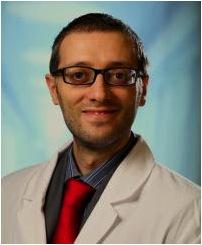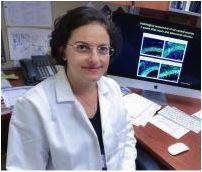
Gaetano Santulli, M.D., Ph.D., a cardiologist at Columbia University Medical Center's College of Physicians and Surgeons, is lead author for the study.
August 26, 2014 — A new therapy developed by researchers at the University of South Florida (USF) Morsani College of Medicine and Columbia University Medical Center (CUMC) may help reduce the life-threatening complications of interventional cardiovascular disease treatment.
The researchers demonstrated in a rat model that the novel molecular therapy could selectively inhibit blood vessel re-narrowing and simultaneously promote vessel healing following a medical procedure using a balloon catheter to open narrowed or blocked arteries.
Their preclinical study appears online in the Journal of Clinical Investigation.
"This innovative microRNA-based strategy can be used to combine anti-proliferative and pro-healing mechanisms for improved repair of coronary arteries," said the study's principal investigator Hana Totary-Jain, Ph.D., assistant professor of molecular pharmacology and physiology at the USF Health Morsani College of Medicine, who came to USF Health from CUMC last year.
"The most significant finding of our study is that for the first time we were able to achieve in one fell swoop both the inhibition of cells responsible for re-narrowing of the vessel, and preserving the 'good' endothelial cells that protect against thrombosis," said lead author Gaetano Santulli, M.D., Ph.D., a cardiologist working at CUMC's College of Physicians & Surgeons.
Angioplasty, the world's most common medical procedure, opens a narrowed or blocked artery by inserting a small balloon into the blood vessel. If the artery is blocked, a stent is placed. The stent holds the artery open and maintains blood flow after angioplasty clears the vessel of fatty deposits. Physicians performed 560,500 angioplasties in the United States in 2011, according to a recent report by the Agency for Healthcare Research & Quality, and, Dr. Santulli said, 70 to 90 percent of all angioplasty patients receive one or more stents.
Together, angioplasty and stenting have helped advance the field of interventional cardiology and save lives.
Drug-eluting stents, first approved for use in the United States in 2003, dramatically reduced rates of restenosis compared to earlier bare metal stents. Medications coating these stents thwart the development of scar tissue causing the treated coronary artery to re-narrow, a complication often requiring another procedure.
While the drug-eluting stent overcame the obstacle of restenosis, research eventually showed that the medications released by the device were not specific — meaning they failed to discriminate between destructive and beneficial cells. The drugs blocked proliferation and migration of vascular smooth muscle cells leading to artery re-narrowing, but they also blocked regrowth of endothelial cells indispensable to healing blood vessel walls disrupted by stent implantation.
Formation of blood clots several months or even years after initial implantation remains a severe, though rare, increased risk associated with the lack of endothelium covering the treated vessel. This risk for late stent clotting, or thrombosis, requires patients to stay on prolonged dual antiplatelet therapy to help prevent life-threatening heart attacks — but not without increasing the odds of major bleeding.
With this history in mind, researchers at USF and CUMC harnessed the intrinsic power of microRNAs — master regulators of gene expression affecting many biological processes including cell proliferation — to create a more selective therapy.
Their goal was to inhibit blood vessel re-narrowing and, at the same time, allow endothelial cells to regrow and heal the vessel. They tested the experimental therapy in a rat model of balloon angioplasty injury, and discovered it worked.
Among the findings:
As soon as two weeks following arterial injury induced by balloon angioplasty, the injured arteries in the rats receiving microRNA-based therapy were 80 percent covered with new endothelium. In the group receiving a molecular therapy that mimicked drug-eluting stents, endothelial cell coverage remained below 30 percent even after one month. "The difference was quite amazing," Totary-Jain said.
Measures of blood clotting in the microRNA-based therapy group at two weeks post-injury were reduced to the same levels as in the uninjured control animals.
In addition to helping protect against thrombosis-associated clotting, the endothelial cells restored in the treated group appeared to work as well in helping dilate blood vessels as endothelial cells in the vessels of the healthy, untreated control group. "From a clinical point of view, reduced thrombosis and functional vascular responses represent the most promising aspects of the whole study," Santulli said.
More studies are needed, including implanting stents to test the therapy in other models of atherosclerosis and diabetes.
"This is just the first step, but we are working on tailoring the strategy to be more effective," Totary-Jain said. "The combination of this selective therapy with a better stent platform and biodegradable polymer has the potential to revolutionize the future of vascular interventional medicine."
For more information: www.health.usf.edu



 April 24, 2024
April 24, 2024 








